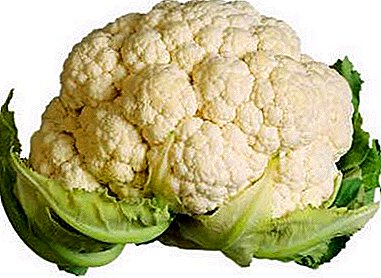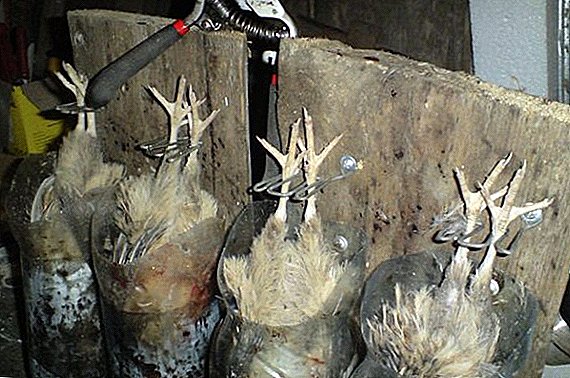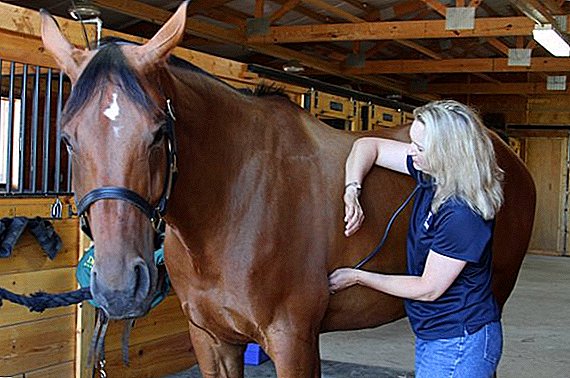 The temperature of the horse is the most important indicator of its health, which is judged on the presence of pathologies and control the effectiveness of the treatment, so you need to pay attention to the symptoms of high or low temperature and measure it if necessary. Let's find out what this indicator should be and what its deviations can testify to.
The temperature of the horse is the most important indicator of its health, which is judged on the presence of pathologies and control the effectiveness of the treatment, so you need to pay attention to the symptoms of high or low temperature and measure it if necessary. Let's find out what this indicator should be and what its deviations can testify to.
Horse's normal temperature
The body temperature of any warm-blooded animals, including horses, provides a mechanism for thermoregulation. The normal temperature of an adult individual is 37.5-38.5 ° C, and in foals it is about half a degree higher and reaches 39 ° C.
Find out how horses can hurt.
At the same time, absolutely healthy animals show small fluctuations of this indicator throughout the day. So, its minimum values are fixed at 3-6 o'clock in the morning, and the maximum - at 5-7 o'clock in the evening.  It is characteristic that much depends on the origin of the animal. For example, the Yakut breed is known for its low daily and annual temperature fluctuations. A breed of Welsh, fjord and Felsk ponies better adapted to the cool climate and usually have a lower body temperature.
It is characteristic that much depends on the origin of the animal. For example, the Yakut breed is known for its low daily and annual temperature fluctuations. A breed of Welsh, fjord and Felsk ponies better adapted to the cool climate and usually have a lower body temperature.
Did you know? The most common horse name in the world is Zhu-han. So often called horses in China, which, as you know, is the most populated country in the world.
Why there may be deviations from the norm
Changes in the physical parameters of the body are influenced by many factors: the environment, physical activity, nutrition, and, of course, the presence of diseases.
Horse fever
Hyperthermia (elevated body temperature) usually indicates the presence of an inflammatory process, including an infectious process. Thus, the constant hyperthermia at 2-2.5 degrees occurs with croupous inflammation of the lungs. Temperature fluctuations, when elevated values are replaced by normal ones, are characteristic of infectious anemia, glanders and myta horses.  Horse Express Cooling Method Infectious diseases also include a fever defense mechanism. This is because the toxins of bacteria and the pyrogens secreted by leukocytes irritate the chemoreceptors and affect the thermoregulation center in the brain.
Horse Express Cooling Method Infectious diseases also include a fever defense mechanism. This is because the toxins of bacteria and the pyrogens secreted by leukocytes irritate the chemoreceptors and affect the thermoregulation center in the brain.
In this case, the heat adversely affects the metabolism of infectious agents, which speeds up the process of recovery of the body. However, prolonged hyperthermia has a devastating effect on the body, and indications reaching up to 41.7 degrees Celsius lead to the death of a horse.
Learn how to bathe, shoe, feed, care for the tail and mane.It is necessary to know that, in addition to high temperature, during fever it is noted:
- chills;
- muscle twitching;
- decreased appetite;
- increased heart rate;
- suppression of salivary gland secretion.
 At elevated temperatures it is important to observe the drinking regime.
At elevated temperatures it is important to observe the drinking regime.
Also, high rates may not be associated with diseases and occur after active work, a long stay in the heat, as well as in females, especially during the period of foal.
Important! In the event of a fever, you should immediately contact the veterinary clinic, where you will diagnose professionally and, if necessary, prescribe the appropriate treatment.
Below normal
Hypothermia (low body temperature) may indicate a violation of metabolic processes in the horse's body. Such, for example, often happens in exhausted and weakened horses or with circulatory disorders. In addition, it happens after a long stay in the cold or drink ice water.
Sometimes hypothermia occurs during a debilitating type of fever. In this case, as the horse recovers, his temperature also returns to normal.  With hypothermia, the horse should be warmly wrapped up. Any owner should be alerted by a sharp drop in the body temperature of the pet by 2-4 degrees Celsius. This usually indicates collapse.
With hypothermia, the horse should be warmly wrapped up. Any owner should be alerted by a sharp drop in the body temperature of the pet by 2-4 degrees Celsius. This usually indicates collapse.
At the same time, the animal has the following phenomena:
- sticky sweat appears;
- blue mucous membranes of the eyes, mouth and genitals due to stagnation of venous blood against the background of heart failure;
- the lower lip hangs down;
- legs are bent;
- tremor is observed.
Typically, these symptoms indicate a rupture of the internal organs - the stomach or intestines.
Did you know? According to the ancient custom of the Mordvins, before they mounted a horse, a woman had to wear two skirts. Thus, she could not insult the sacred animal by the occasional touch of her body.
How to measure the temperature of a horse
This procedure is performed by the rectal method, and usually it is done by the owner of the horse, to which she is accustomed and trusted. If it is necessary to measure the temperature of an unfamiliar animal, you should first tame it by offering a favorite delicacy.  It is also recommended to use petroleum jelly or other lubricant. For the procedure it is more convenient to use a digital thermometer, which beeps after the measurements have stabilized and has a convenient screen for reading data. You can use a mercury thermometer, after making sure that there are no cracks and dirt on it. You must also stock up with rubber or latex gloves.
It is also recommended to use petroleum jelly or other lubricant. For the procedure it is more convenient to use a digital thermometer, which beeps after the measurements have stabilized and has a convenient screen for reading data. You can use a mercury thermometer, after making sure that there are no cracks and dirt on it. You must also stock up with rubber or latex gloves.
Familiarize yourself with the structure and diseases of the horse's eyes and limbs.Step-by-step instruction:
- It is good to tie a horse to a fence or a pole or place it in a machine so that it will be fixed during the procedure.

- Stand next to the horse on the left side. Stay close enough for the horse to kick.
- Lubricate the tip of the thermometer with soapy water. When using a digital thermometer, try to keep water away from the battery.
- Make sure that one hand is free so that it can raise its tail. If necessary, take a thermometer in the mouth (non-measuring end), which will release another hand.
- Approach the horse’s rump from the front at an angle so that she can see you and not be frightened.
- Position the thermometer so that one hand goes along the horse's back, holding its attention and showing that you are still there.
- Raise the tail with your free hand and, if there are obvious dry areas in the area of the rectal opening, apply soapy water to them with a sponge or sprayer.

- Carefully insert the thermometer into the rectum. Gently press on him, aiming at the nearest side of the horse (at himself). In this case, the tip should be at the intestinal wall, and not inside the feces, where the temperature is higher. Talk calmly with the horse so that it does not worry.
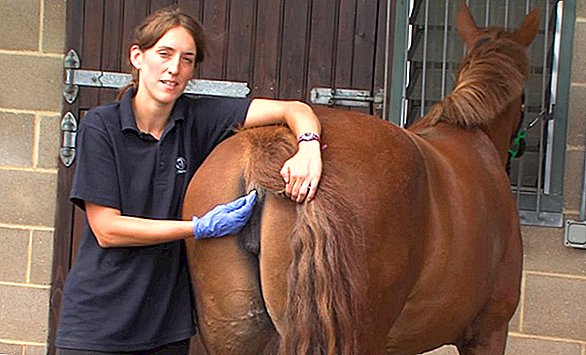
- Wait for the thermometer to stabilize. With a digital thermometer it may take 30-120 seconds. A mercury thermometer is kept in the gut for up to 10 minutes. To the thermometer did not go deep into and did not fall out, it is tied with a bandage with a strong clothespin at the opposite end and fixed for the hair of the tail replica.
 Fixing a mercury thermometer with a rope and clothespins
Fixing a mercury thermometer with a rope and clothespins - Carefully remove the thermometer by pulling it at the same angle at which it was inserted. Do not pull or pull too fast. After extraction, the horse may emit gases.
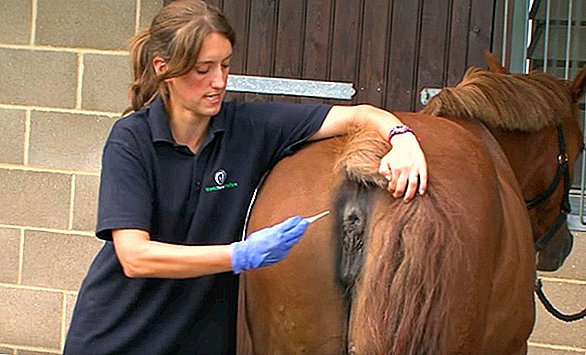
- Record testimony. Periodic temperature check allows you to track its dynamics. Usually in the early morning readings will be lower than during the day or at night. They will also be higher on a hot day compared to a cool one.
- Turn off the thermometer and disinfect with hot (but not boiling) water and cleaning agent. Dry with a soft cloth. Just in case, leave to dry without packaging for another 2-3 hours.

Important! In order that during the procedure there should be no “surprise”, it is better to carry it out after the horse has defecated and released the gases.Thermometry is one of the main diagnostic techniques when inspecting a horse. A change in body temperature of only one degree in any direction from the norm is already considered a sign of abnormalities in the body, so it is extremely important to monitor the normal body temperature of the animal in order to prevent the development of pathology. And always remember that only constant care, good care and proper nutrition will ensure good health for your pet.





 Fixing a mercury thermometer with a rope and clothespins
Fixing a mercury thermometer with a rope and clothespins


